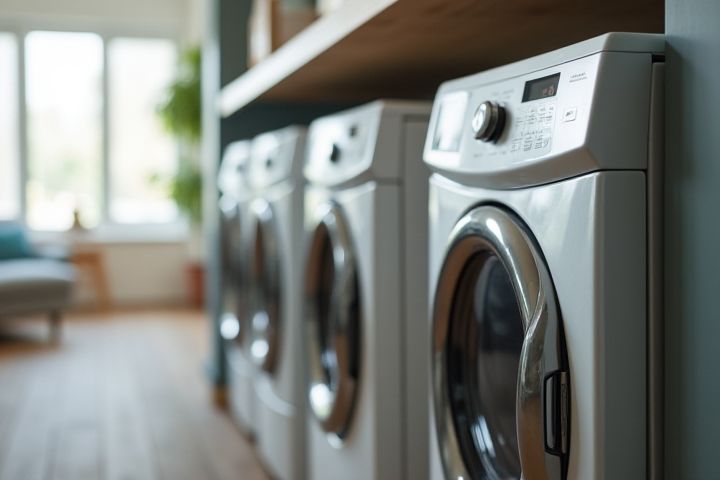
Updating house appliances is crucial for maintaining efficiency and ensuring safety. If your appliance is over 10 years old, it may be time for a replacement, as older models can consume more energy and have outdated features. Look for signs like unusual noises, frequent repairs, or inconsistent performance, which indicate that your appliance might need an upgrade. You should also consider updating if you're renovating or if newer technologies, such as smart appliances, can significantly improve your home's efficiency and convenience. Regular maintenance and energy audits can help in deciding the right time for an upgrade, ensuring that you make informed choices for your home.
When To Update House Appliances
Performance decline
Performance decline in household appliances often signals the need for an upgrade. If your refrigerator struggles to maintain a consistent temperature, leading to food spoilage, or if you notice a significant increase in energy bills--more than 10% compared to previous years--it's time to consider replacement. For washing machines, excessive vibrations or prolonged cycle times indicate wear and tear that could impact efficiency. Generally, if an appliance is over 10 years old and exhibits frequent repairs or inefficiencies, investing in a new model can lead to higher performance and energy savings.
Rising energy bills
Rising energy bills can be a clear indicator that it's time to update your house appliances. Energy-efficient models can significantly lower your utility costs, with savings ranging from 10% to 50% compared to older appliances. Consider replacing appliances that are over 10-15 years old, as they often consume more energy and lead to higher monthly expenses. Investing in ENERGY STAR certified devices not only contributes to lower bills but also helps reduce your carbon footprint.
Frequent repairs
If you find yourself making frequent repairs on your appliances, consider replacing them instead. Appliances that need repairs multiple times within a year often indicate declining efficiency, with repair costs potentially surpassing replacement expenses. For example, a refrigerator that requires repair more than twice a year might lead to higher energy bills, as older models typically consume more electricity. To maximize your investment, aim to upgrade when repair bills exceed 50% of the cost of a new model, ensuring optimal performance and potential savings in the long run.
Technological advancements
Consider upgrading your house appliances when they become outdated due to significant technological advancements. For instance, smart refrigerators now feature Wi-Fi connectivity, allowing you to manage food inventory and energy consumption directly from your smartphone. Energy-efficient models, such as those with the ENERGY STAR certification, not only reduce your utility bills but also minimize your carbon footprint. You can enhance your home's efficiency and convenience by keeping an eye on new developments, ensuring that your appliances leverage the latest innovations.
Safety concerns
Regularly updating your house appliances is crucial for safety, especially if they are more than 10 years old, as older models may lack essential safety features that comply with modern standards. For example, outdated microwaves can pose risks of radiation leaks, while older dryers are known to be a major fire hazard, causing approximately 15,500 fires annually in the U.S. If your appliance exhibits strange noises, emits unusual smells, or shows inconsistent performance, it is vital to consider replacing it immediately. Prioritize appliances with updated safety certifications, such as UL or CSA labels, to ensure your home remains a safe environment for you and your family.
Outdated style
Outdated appliances can significantly impact your home's aesthetic and energy efficiency, leading to increased utility bills. If your appliances are over 10 years old, it's time to consider replacements, as modern models are designed with better energy ratings, saving you up to 30% on electricity costs. An outdated style not only detracts from your home's value but can also affect functionality--replacing these appliances often enhances convenience and performance. Evaluate your kitchen and laundry room every few years to assess whether those dishwashers or refrigerators still meet your needs and align with your desired decor.
Manufacturer discontinuation
If your house appliances are from a manufacturer that has formally announced discontinuation, it's crucial to consider updating them within the next six months. Discontinued models often face dwindling availability for replacement parts, leading to potential repair challenges and increased costs. Additionally, with an estimated 15% of homes experiencing appliance failures due to obsolescence, you may incur higher energy bills from outdated models. You can enhance efficiency and safety by upgrading to newer, ENERGY STAR-rated appliances, which can lower your monthly utility costs by an average of 10-50%.
Warranty expiration
Monitoring your home appliances for warranty expiration is crucial for timely updates and cost savings. Most warranties typically span from one to five years, depending on the appliance type, so check the specific terms for each item in your home. If your appliance is nearing the end of its warranty period, consider its performance; symptoms of inefficiency or frequent repairs could warrant an early replacement. Addressing these issues before the expiration date can help you avoid costly repairs or replacements without coverage.
Environmental impact
Updating your house appliances can significantly reduce your environmental footprint. Energy-efficient appliances can lower energy consumption by up to 50%, translating to substantial savings on your utility bills and decreased greenhouse gas emissions. If your appliances are over ten years old, consider replacing them, as newer models often adhere to strict energy standards. Look for ENERGY STAR labels, which indicate that the appliance meets energy efficiency guidelines set by the U.S. Environmental Protection Agency.
Incentive programs
Many local and state governments offer incentive programs to encourage homeowners to upgrade outdated appliances to more energy-efficient models. These programs often provide rebates ranging from $50 to $500, based on the appliance's energy rating and may even include tax credits. Replacing older appliances, such as refrigerators over 10 years old or washing machines older than 15 years, can lead to annual energy savings of up to 30%. You should research available incentives to maximize your savings while enhancing your home's efficiency and reducing monthly utility bills.
